|
RUG GUIDE
Rug Introduction 
The Illustrated Rug 
From Sheep To Rug 
Rug & Knot Types 
Rug Loom Types 
Basic Rug Care 
Stain Removal Guide 
Decorating Ideas 
Purchasing Guide 
Rug Names & Places 
Rug History Chart 
Glossary of Terms 
|
Presented by NEJAD RUGS:
The Fine Art of Persian Carpet Weaving
Samples from the 16th - 19th Centuries
From recorded history the carpets of the near east were renowned for their splendor
and magnificence - Persian carpets in particular.
Indeed, and perhaps not surprisingly, the oldest known rug is from Persia,
and as early as the 6th Century the Persian carpet had attained
prestige enough, according to the Sui annals ( Sui-su, Laufer, Sino-Iranica ),
to have been commercially exported to places as far distant as China.
Also, it is acknowledged that Persian carpet weavers, by this time
had already achieved
some variety with regard to both technique and materials: wool or silk -
either pile or tapestry woven, embroidered, or even of shuttle-woven silk
( Pope, A Survey of Persian Art ).
|
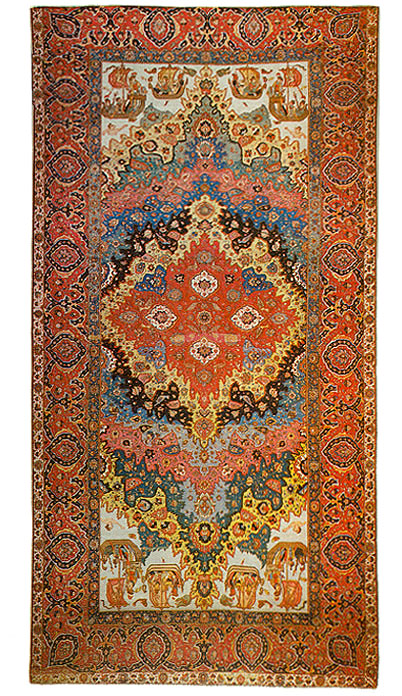
Classical Persian Royal Carpet
with Large Center Medallion
(Persia)
|
|
It could be observed that carpet weaving,
or at least it's proliferation and elevation to a high art form, was,
for the most part, a kingly concern and invention, and one not necessarily limited to
(i.e. France) near eastern lands.
As can be observed centuries later in France (and the court at Versailles), as in Persia,
control of artistic as well as the productive concerns with regards to both the making
of and the use and enjoyment of carpets and tapestry weavings began with, and was the
exclusive domain of, royalty.
Moreover certain types, large and/or exotic carpets especially,
were reserved for court use, and so costly that they were considered important
items in the royal treasury - carpets of stunning grandeur that often used silk instead
of, or in addition to, wool and genuine silver and gold thread and/or semiprecious jewels:
it has been reported that the Caliph Harun al-Rashid had no less than 22,000 fine rugs
adorning his palace.
|
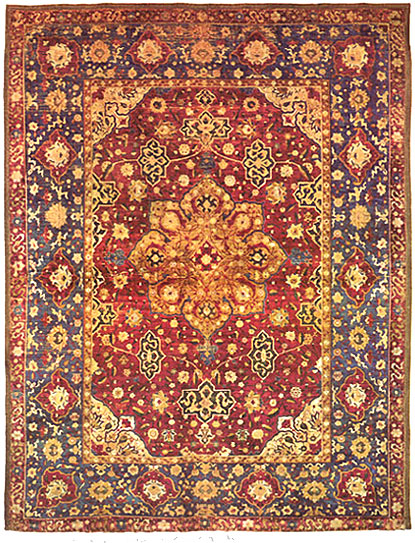
16th Century Silk
with Medallion
(Persia) |
The carpets of royalty were generally of the "medallion" type,
characterized by complex arabesque designs around a central motif, and sometimes
extending over 25 feet in length. Under the direction of a salim (foreman), who chanted instructions as to
color sequences etc., the Muslim carpetmaker could painstakingly tie up to
900 knots an hour, with an average weave or knot density of 320 knots to the
square inch. Peter the Great, wealthy Czar of Russia, is known to have given the
Royal House of Hapsburg, in Austria, a silk medallion Persian
carpet of 783 knots per square inch that took several years to weave.
|
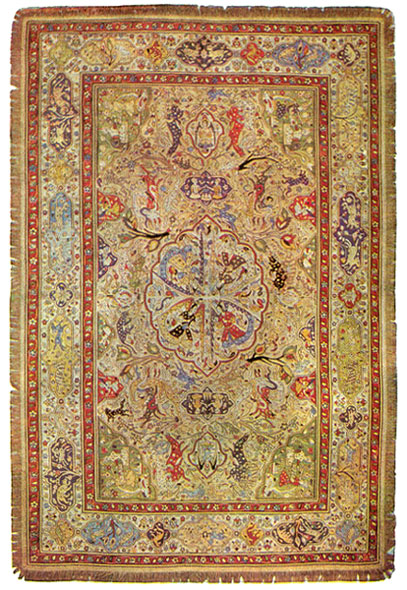
17th Century Woven Silk
(Persia) |
The devastation of the 13th century Mongol invasion certainly depressed the artistic
and cultural pursuits of most of Persia, this situation only partially remediated by
the architectural and artistic achievements of the Ilkhan renaissance
(1290-1355).
The bloody conquests of Tamerlane were disastrous to Persia, however, under his rule
favoured artisans were spared, and were removed in large numbers to work on his great
palaces in Turkistan, particularly at Samarkand and Bukhara, where
they were chiefly responsible for a new school of decorative art and design. |

17th Century Brocaded Silk
(Persia) |
|
Out of this, under the enlightened and cultivated rule of Tamerlane's successors,
particularly Shah Rukh (1377-1447) and Baizangur (1396-1433), literature
and the arts flourished - and especially the fine art of rug weaving
which would reach its zenith in the magnificent Persia carpet of the 16th century.
Like most of the finest art of the times, these carpets were produced in palace ateliers
on court-subsidized looms - thus making for unity and integrity of style.
Meanwhile a sensitive yet exacting clientele imposed the highest standards -
such lavish royal support insuring masterful technical proficiency as well as the
provision of the most suitable raw materials. All these conditions and advantages were
provided under the Timurids through the 15th century and under the Safavids.
|
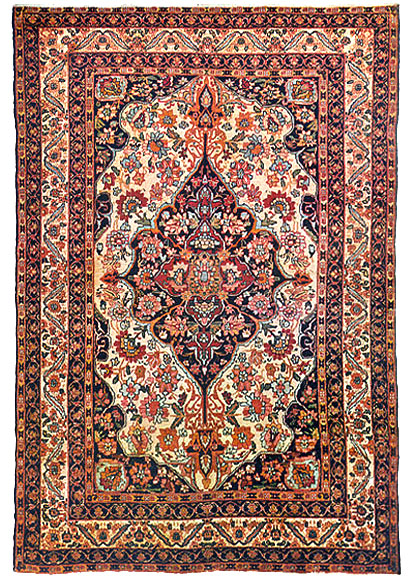
19th Century Silk Kerman
(Persia) |
|
Beautiful rug design was, to varying degree,
appropriated by other arts - the illuminator given
authority over the weaver, who was relegated to the role of mere assistant.
However such domination by gifted artists accounts in no small
measure for the special character of the court carpets of the
period: the variety of color, the ingenuity and imaginative range
of pattern schemes, the lucid and expressive, yet precise, draftsmanship
- elevating these products to a rank equivalent to that of great
classical painting. Remarkably, John Singer Sargent, as well as Sir Charles Holmes,
had both on separate occasions, and referring to different 16th century carpets,
made the following emphatic point of comparison: "There is more art in a really great carpet than in any
picture ever painted."
|
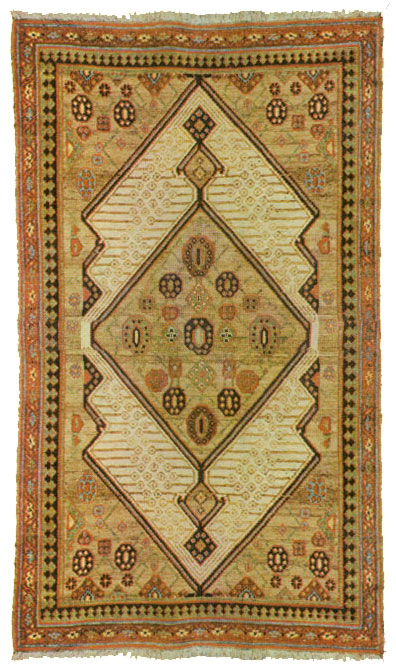
19th Century Hamadan
(Persia) |
|
By the 15th and 16th centuries Persian carpets began to be incorporated into the paintings of
prominent European artists, many of whom also owned them,
and Van Dyke and Breughel, in particular, rendered them with such complete
fidelity
that these carpets can be accurately identified with respect to production details.
Other depictions by Flemish artists i.e. Memling, Van
Eyck, Cristus render the carpet detail so carefully that even
the individual knots are sometimes visible.
|
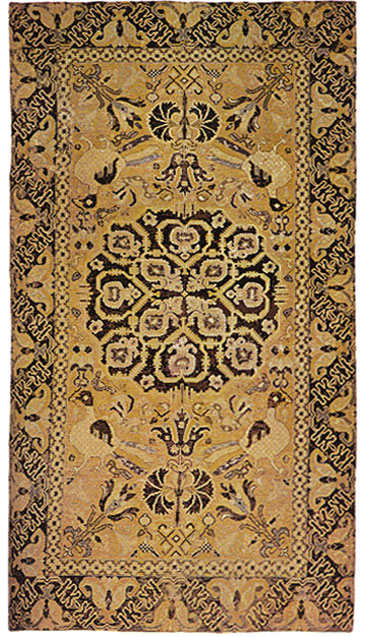
18th Century Hamadan
(Persia) |
| It has been accepted practice to name the great court carpets of the 16th century in
accordance with apparent motifs that appear in the artwork itself,
irrespective of region perhaps i.e.: Hunting carpets, Garden carpets,
Medallion carpets, Vase carpets, and of course Prayer
carpets.
By the 19th century the principal weaving centers in Persia were Tabriz
in the northwest, Joshaghan in central Persia, Kerman and Ravar in the southeast,
Meshed in the northeast, the Sultanabad district in Western Persia, and Kashan -
noted for its fine textiles as early as the 12th cehtury.
These centers have all woven large carpets, Meshed, Kerman and Tabriz utilizing the
medallion schemes of early classical time, Joshaghan and
some Kerman carpets repeating various interpretations of the garden motive.
|
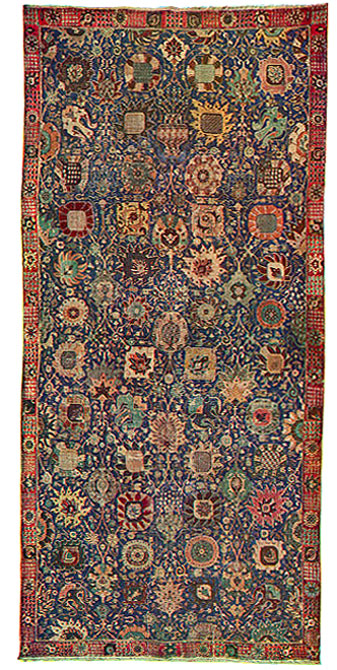
17th Century Vase Carpet
(Persia) |
-
Joshaghan, 60 miles northwest of Isfahan, wove the great Vase
carpets of the Sefavid period and like Kashan and Tabriz continued fine weaving
down to the present day. During the 19th century the most characteristic Joshaghans
were distinguished by flower sprays, very precisely drawn, on a field of soft red.
-
From Sultanabad came beautifully woven Sarouks - characterized by ancient medallion
pattern, Sarabandes - with repeating boute patterns, Ferraghan - with an all-over Herati
pattern on a field of dark lustrous blue and a pattern delicately drawn and clear
and open.
-
Kerman rugs, made of brilliant wool and featuring a somewhat luminous color palette
with intricate motif, are finely and skilfully woven, and by the late 19th century
became the most favoured of all the Persian weavings - particularly suitable to the
western drawing room of the late 19th century.
-
From the province of Fars come a large number of seminomadic rugs and a few
large-scale carpets, reflecting ancient models.
The Bahtiari region west of Isfahan is known to have produced
large double-warp stoutly woven carpets - attaining considerable recognition.
-
Northeastern Persia from Meshed down to Birjand and Ghayian produced large carpets
predominantly violet or purplish in tone with wide multiple
borders and of a very soft wool.
Some of the finest rugs made today come from special looms in Meshed
and Birjand which have been especially favoured by court orders.
The materials are excellent, the weaving leaves nothing to be desired,
the colours are beautifully toned and need no chemical
washing as do most contemporary eastern carpets, though the
designs still lack the spaciousness, the originality and expressive
power of earlier days.
-
By the 16th century Kashan was producing the sumptuous velvets rivalled by even more
sumptuous silks and in the 17th by the silver and gold-threaded rugs called Polonaise
carpets. The skill and tradition survived and Kashan has produced the finest woven, most
elaborately designed, richly coloured rugs of recent times. Their high cost restricted the
output and the best of them were finally crowded out of the market.
The Illustrated Rug - Part 1
| The Illustrated Rug - Part 2
| Rugs & Weavings of Afghanistan
|
|
© 2007 Nejad Rugs - All rights reserved
|




















